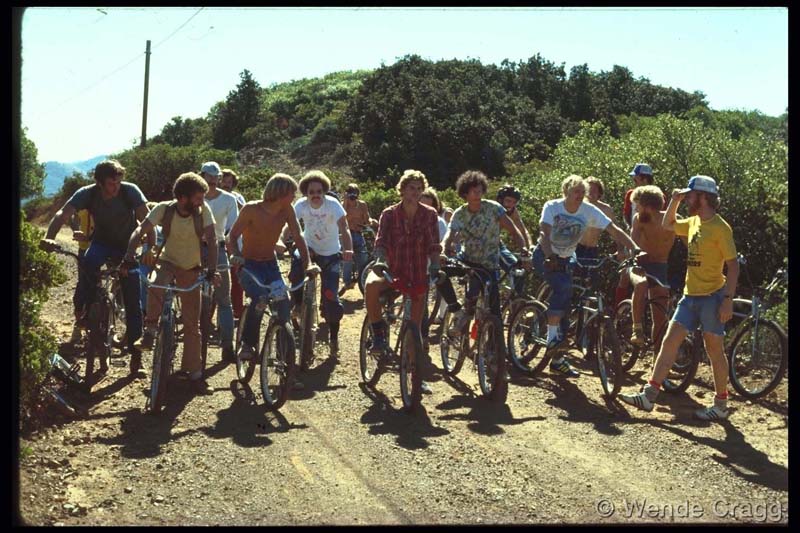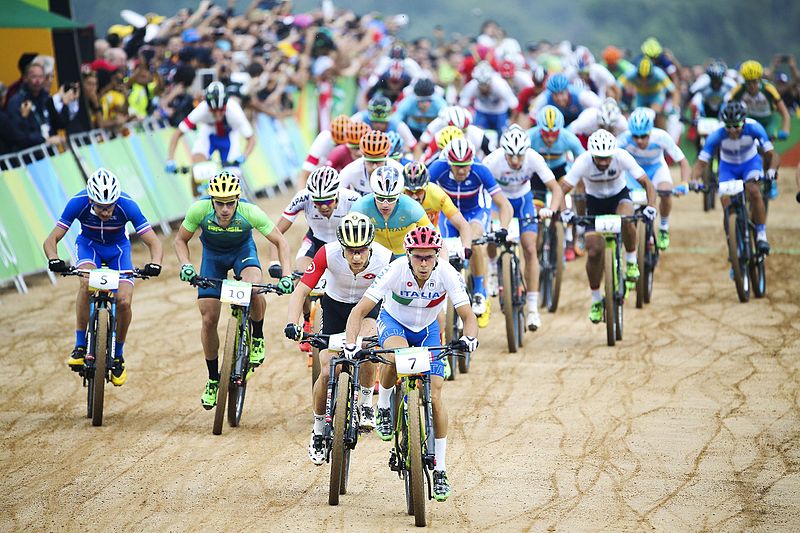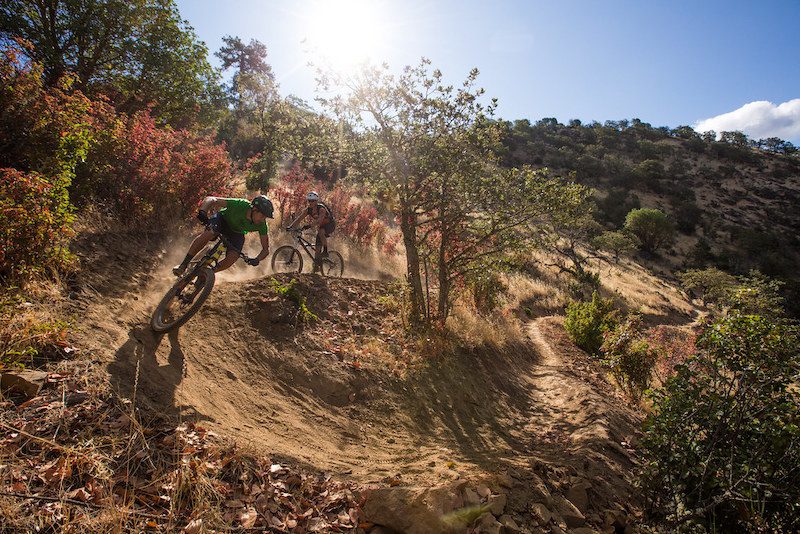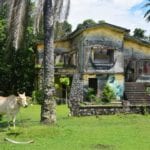Last Updated on 26 June 2024 by Cycloscope

Discover the rich history of mountain biking and learn about the first ever MTB race. Explore when mountain biking started and its journey to the Olympics. Get the facts now.
Mountain biking is a sport that has taken the world by storm, and its popularity continues to grow each day.
The sport is as exhilarating as it is challenging, taking riders through rugged terrains and steep inclines, pushing their limits and testing their resolve.
In this blog post, we will embark on a journey through time to discover the rich and fascinating history of mountain biking, tracing its origins to the present day.
Check Also
> The 12 Brightest bike lights for night cycling
> The 9 Best Mountain Bike Computers: A Comprehensive Guide
> 16 MUST-HAVE Bike Accessories! The Best Cycling Gadgets in 2024
The Early Days of Off-Road Cycling

The modern process of constructing roads using tarmac, or asphalt concrete, was developed in the late 19th century, so we can say that all cycling done before tarmac was off-road cycling.
bicycles were used by the US Army in the late 19th century. During the Spanish-American War in 1898, the Army utilized bicycles as a means of transportation for scouting and messenger duties. Bicycles were considered to be a quick and efficient mode of transportation at the time, and they were well-suited for the rough terrain of Cuba, where the war was fought.
Bicycles were also used by the British Army in the Sudan campaign of 1896, and by the Russian Army in the Russo-Japanese War of 1904-1905.
The versatility and practicality of bicycles made them a popular choice for military use, and their continued development and evolution as a tool for military operations helped to lay the foundation for the modern bicycle and its many applications.
However, the first organized and recorded off-road cycling events are often credited to the pioneers of mountain biking in Marin County.
A brief history of suspension in bicycles, and how we got to modern Mountain Bikes

The history of suspension systems in bicycles is a story of innovation and evolution, driven by a desire to improve the comfort and control of bikes on rough terrain. Over the years, several key innovations have helped to advance the state of bicycle suspension technology and transform the way bikes are designed and built.
One of the earliest innovations in bicycle suspension was the leaf spring fork, which was patented in 1885. This system used a spring made of flat steel plates to absorb shocks and vibrations from the terrain. Although the leaf spring fork was a step forward in suspension technology, it was heavy and not very effective at absorbing shocks.
In the 1930s, hydraulic suspension systems were introduced, which used oil-filled shocks to absorb impacts. These systems were an improvement over the leaf spring forks, but they were still heavy and not very effective.
In the 1960s and 1970s, advancements in materials science and manufacturing techniques led to the development of lightweight and reliable suspension systems. One of the key innovations of this period was the introduction of elastomer suspension, which used flexible rubber components to absorb shocks and vibrations.
This system was lighter and more effective than earlier suspension systems, and it marked a major turning point in the development of bicycle suspension technology.
In the 1990s and 2000s, the development of air suspension systems further advanced the state of bicycle suspension. Air suspension systems use air chambers, similar to the shocks found in motor vehicles, to absorb shocks and vibrations.
These systems are highly adjustable, making it possible to fine-tune the suspension to suit the rider’s weight and riding style. They are lighter and more effective than earlier suspension systems, and they have become a popular choice for mountain bikes and other off-road bicycles.
Today, suspension systems continue to evolve, and there are a variety of options available to suit different riding styles and terrains. From the early leaf spring forks to the sophisticated air suspension systems of today, the history of suspension systems in bicycles is a testament to the enduring spirit of human innovation and progress.
The Larkspur Canyon Gang and the birth of MTB racing

So, allow me to take you back to 1971, when a small group of wild teens in Marin County, California, set out on a pioneering journey into the unknown. They called themselves “The Larkspur Canyon Gang“.
They were searching for a new challenge, a way to escape the crowded roads and experience the thrill of off-road cycling. They found what they were looking for on the rugged terrains and steep inclines of Mount Tamalpais, where they began exploring the trails on heavy, modified beach cruisers. These were the pioneers of mountain biking, and their journey marked the birth of a sport that would go on to captivate millions of riders across the world.
To set in stone who was the best (or craziest) rider, they set-up a somehow suicidal race down the Temalpais. On October 21, 1976, ten local riders showed up to test their mettle. The Great Race was won by the most wicked of them all, a guy called John Y, who could be considered the first MTB champion.
The race was held for three consecutive years, and renamed the Repack Race, attracting more and more people every year from the Bay area and beyond.

Following in the tracks of the Larkspur Canyon Gang, more and more reckless folks started unofficial races, a sort of underground movement, but in the woods.
The early days of mountain biking were a time of experimentation and innovation, as riders pushed the limits of what was possible on a bicycle.
They modified their bikes to better suit the rugged terrain, adding stronger brakes, fatter tires, and sturdier frames. These early mountain bikers faced countless challenges and obstacles, but they persevered, driven by a passion for adventure and a love of the sport.
They paved the way for generations of riders to come, and their legacy lives on today in the form of the vibrant mountain biking community that continues to grow and evolve.
The Birth of Mountain Bike Racing and the Golden Age of Mountain Biking

As the sport gained popularity, dedicated mountain bikes were manufactured to meet the demands of the growing community of off-road riders. The early mountain bikes were heavy and rugged, designed to withstand the rigors of off-road cycling. They were a far cry from the lightweight and agile machines that we see today, but they were the foundation upon which the sport was built.
This new form of cycling quickly gained popularity, and soon, dedicated mountain bikes were being manufactured to meet the demands of the growing community of off-road riders.
The 1980s and 90s marked the golden age of mountain biking, with the sport experiencing rapid growth and expansion. New mountain biking techniques were developed, and the sport became more accessible to a wider audience, attracting riders of all ages and abilities.
The introduction of suspension systems and the use of lightweight materials revolutionized the sport, making it faster, smoother, and more accessible. This was also the time when mountain biking was recognized as an Olympic sport, further boosting its popularity and reach.
IMBA, the first MTB federation
The International Mountain Bicycling Association (IMBA) is a trailblazer in the world of mountain biking. Established in 1988, IMBA has been the driving force behind the promotion and preservation of mountain biking as a sport. This non-profit organization has worked tirelessly for almost four decades to secure access to trails and riding areas for mountain bikers through partnerships with land managers, advocacy groups, and local communities.
But IMBA doesn’t just work to create opportunities for riders, it’s also passionate about educating the wider community about the benefits of mountain biking and promoting responsible riding practices. With a focus on sustainable trail systems, IMBA is dedicated to preserving the sport for generations to come.
Today, IMBA’s voice is recognized and respected throughout the mountain biking community, and the organization continues to play a vital role in shaping the future of the sport. Whether you’re a seasoned rider or a newcomer to the sport, IMBA is an essential ally in the world of mountain biking.
The first Mountain Bike championships
The first official MTB National Championship in the US was not organized by the IMBA though, but by USA Cycling, the governing body of all cycling in the USA, through its branch named NORBA (National Off-Road Bicycle Association). The history of this organization traces back to 1920, when it was first founded under the name “Amateur Bicycle League of America”, and later renamed into USA Cycling in 1975.
The very first NORBA championship was a cross-country race held in 1984, at Eldora, Colorado (near Boulder), and won by the legendary Joe Murray, who later made an immense contribution to the mountain biking world as a designer. Women had to wait one more year to participate in the event, with Jacquie Phelan being the first women MTB champion in 1985.
To see an international championship though, MTB enthusiasts had to wait for 1990, when UCI (Union Cycliste Internationale) organized the very first world mountain bike championship in Durango, Colorado. It initially included only the cross country discipline and was won by Dutchman Ned Overend, again one more year was needed to see women participating, with the win of Canadian Cindy Devine. Downhill MTB was added two years later and the crown was conquered by two Germans, Jürgen Beneke and Regina Stiefl.
MTB in the Olympic Games

The 1996 Summer Olympics in Atlanta, Georgia marked a seminal moment in the history of mountain biking, as it was here that the sport was first introduced to the Olympic stage.
The eyes of the world were upon the athletes as they gathered to compete in the first-ever Olympic mountain bike race – the men’s cross-country event. The course was a challenging mix of terrain, from steep climbs to technical descents, and the riders pushed themselves to their limits to claim the coveted title of Olympic champion.
And, in the end, the gold medal went to Bart Jan Bruneflies of the Netherlands, who emerged victorious after a grueling race that tested both his physical and mental fortitude. It was a moment that would be remembered for years to come, not just for the achievement of the athletes but for what it represented: the recognition of mountain biking as a legitimate and thrilling sport worthy of Olympic competition.
It was a fitting tribute to the pioneers of the sport who, only a few decades prior, had taken to the hills with their rugged, all-terrain bikes, seeking to push the boundaries of what was possible. And now, here at the Olympics, mountain biking has finally taken its place among the world’s greatest athletic competitions.
The first-ever Mountain Bike

The Specialized Stumpjumper, released in 1981, was a milestone in the history of mountain biking. It was the first bike designed specifically for off-road riding and had several key technical features that set it apart from other bikes of the time.
These included a lightweight frame made from high-strength materials, wide tires with aggressive tread patterns for better traction, and a variety of other design elements that improved its handling and stability on rough terrain.
The Stumpjumper was also one of the first bikes to incorporate modern suspension systems, which helped to absorb shock and provide a smoother, more comfortable ride.
These technical innovations and others made the Stumpjumper a game-changer in the world of mountain biking and helped to lay the foundation for the modern mountain bike as we know it today.
The Modern Era of Mountain Biking

Today, mountain biking has become a truly global sport, with millions of riders across the world taking to the trails. The sport continues to evolve, with the introduction of electric mountain bikes and the growing popularity of enduro racing.
Mountain biking has also become more accessible, with the development of bike parks and trails that cater to riders of all levels. The sport has come a long way since its humble beginnings in Marin County, California, and its future looks brighter than ever.
The history of mountain biking is a story of passion, determination, and evolution. From its humble beginnings in Marin County, California, to its status as a global sport, mountain biking has come a long way and continues to grow in popularity and reach.
Whether you are a seasoned rider or a newcomer to the sport, mountain biking offers an unparalleled experience, challenging riders to push their limits and explore new trails. So, grab your bike, hit the trails, and experience the thrill of mountain biking for yourself!
FAQs about MTB history
What was the first mountain bike race?
The first mountain bike race was the “Repack Downhill” race, which was held in Marin County, California, in 1976.
When was mountain biking recognized as an Olympic sport?
Mountain biking was recognized as an Olympic sport in 1996, when it was included in the Summer Games for the first time.
When and where did mountain biking originate?
Mountain biking originated in the late 1970s in Marin County, California. The sport developed from a group of cyclists who enjoyed riding modified cruiser bicycles down rugged trails and fire roads.
Who are considered the pioneers of mountain biking?
The pioneers of mountain biking include Gary Fisher, Joe Breeze, Tom Ritchey, Charlie Kelly, and Keith Bontrager. They were part of a group of cyclists known as the “Repack Riders,” named after the Repack Road in Marin County where they raced.
What was the significance of the Repack Road?
Repack Road was a steep, technical descent in Marin County where the early mountain bikers held informal downhill races. The road got its name because riders had to repack their coaster brakes with grease after every run due to the intense heat generated by braking.


